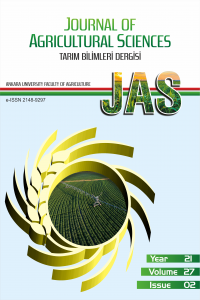An efficient Regeneration Protocol for in vitro Direct Organogenesis in Einkorn (Triticum monococcum L.) Wheat
An efficient Regeneration Protocol for in vitro Direct Organogenesis in Einkorn (Triticum monococcum L.) Wheat
Coleoptile direct regeneration protocol, tissue culture, einkorn wheat (Triticum monococcum ssp. monococcum),
___
- Alikina OM, Chernobrovkina S, Dolgov, Miroshnichenko D (2010) Tissue culture efficiency of wheat species with different genomic formulas. Crop Breeding and Applied Biotechnology 16: 307-314.
- Benlioğlu B, Birsin MA (2017) A thidizuron (TDZ) – based efficient plant regeneration system from callus cultures, obtanined through various embryo sources, in common winter wheat (Triticum aestivum L.). Ciência e Técnica Vitivinícola 32:108-119.
- Charriere F, Sotta B, Emile M, Günther H (1999) Induction of adventitious shoots or somatic embryos on in vitro cultured zygotic embryos of Helianthus annuus: variation of endogenous hormone levels. Plant Physiol Biochem 37:751–757.
- Dale PJ, Deambrogio E (1979) A Comparison of callus induction and plant regeneration from different explants of Hordeum vulgare. Zeitschrift für Pflanzenphysiologie 94: 65-77.
- Ekmekci H, Aasim M (2014) In vitro plant regeneration of Turkish sweet basil (Ocimum basilicum). The Journal of Animal & Plant Sciences 24(6)1758-1765.
- Goncharov NP (2011) Genus Triticum L. taxonomy: the present and the future. Plant Systematics and Evolution 295: 1-11. Gurel E, Wren MJ (1995) In vitro development from leaf explants of sugar beet (Beta vulgaris L.) Rhizogenesis and the effect of sequential exposure to auxin and cytokinin. Ann Bot 75:31–38.
- Hassan MU, Ahmed Z, Munir M, Malik SI, Shahzad K (2009) Effect of sorbitol in callus induction and plant regeneration in wheat. African J Biotechnol 8(23): 6529- 6535.
- Hidalgoa A, Andrea BA, Pompeia C, Piscozzia R (2006) Carotenoids and tocols of einkorn wheat (Triticum monococcum ssp. monococcum L.). Journal of Cereal Science 44: 182–193.
- Kilinc M (2004) Effects of dicamba concentration on the embryo cultures of some bread wheat (Triticum aestivum L.) genotypes. Biotechnol Biotechnol Equip 58-61.
- Kopertekh LG, Stribnaya A (2003) Regeneration from wheat leaf explants. Russian Journal of Plant Physiology 50(3): 365-369.
- Lazar MD, Collins GB, Vian WE (1983) Genetic and environmental effects on the growth and differentiation of wheat somatic cell cultures. Journal of Heredity 74: 353-357.
- Longin CF, Reif JC (2014) Redesigning the exploitation of wheat genetic resources. Trends in Plant Science 19: 631-636.
- Mahmood IA, Razzaq Z, Khan I, Hafiz A, Kaleem S (2012) Evaluation of tissue culture responses of promising wheat (Triticum aestivum L.) cultivars and development of an efficient regeneration system. Pakistan J Bot 44: 277-284.
- Murashige T, Skoog F (1962) A revised medium for rapid growth and bio assays with tobacco tissue cultures. Physiol Plantarum 15: 473-497.
- Nasircilar AG, Turgu K, Fiskin K (2006) Callus induction and plant regeneration from mature embryos of different wheat genotypes. Pakistan J Bot 2006; 38(2): 637-645.
- Nesbitt M, Samuel D (1996) From staple crop to extinction? The archaeology and history of the hulled wheat. In: Padulosi S, Hammer K, Heller J (eds) Hulled wheats, promoting the conservation and used of underutilized and neglected crops. IPGRI, Rome 1996; p. 40–99.
- Nevo E (2011) Triticum. In Kole C (ed) Wild crop relatives: genomic and breeding resources, cereals. Springer Verlag, Berlin, 2011; p. 407-456.
- Örgeç M Karakaş FP, Şahin G, Ağıl F, Zencirci N (2018) Einkorn (Triticum monococcum spp. monococcum) In Vitro propagation sterilization protocol. International Journal of Secondary Metabolite 5(2): 67-74.
- Özgen M, Birsin MA, Benlioglu B (2017) Biotechnological characterization of a diverse set of wheat progenitors (Aegilops sp. and Triticum sp.) using callus culture parameters. Plant Genetic Resources 15(01):45-50.
- Phippen WB, Simon JE (2000) Shoot regeneration of young leaf explants from basil (Ocimum basilicum L.). In Vitro Cell Dev Biol Plant 36: 250–254.
- Sarker RH, Biswas A (2002) In vitro plantlet regeneration and Agrobacterium-mediated genetic transformation of wheat (Triticum aestivum L.). Plant Tissue Cult 12: 155- 165.
- Satyavathi VV, Jauhar PP, Elias EM, Rao MB (2004) Effects of growth regulators on in vitro plant regeneration in durum wheat. Crop Sci 44: 1839-1846.
- Wang J, Bao M (2007) Plant regeneration of pansy (Viola wittrockiana) ‘Caidie’ via petiole-derived callus. Sci Hortic Amsterdam 111: 266–270.
- Yucesan B, Turker AU, Gurel E (2007) TDZ-induced high frequency plant regeneration through multiple shoot formation in witloof chicory (Cichorium intybus L.). Plant Cell Tiss Org Cult 91: 243–250.
- ISSN: 1300-7580
- Yayın Aralığı: Yılda 4 Sayı
- Başlangıç: 1995
- Yayıncı: Ankara Üniversitesi
Possibilities of Use Fertilizer Industry Waste Gypsum Material of Improve Sodic and Boron Soils
Barış BAHÇECİ, Ali Fuat TARI, İdris BAHCECİ
Hüseyin KARAKAYA, Murat YILMAZTEKİN
Genetic Characterization of Some Species of Vetch (VICIA L.) Grown in Turkey with SSR Markers
Cebrail YILDIRIM, Onur OKUMUŞ, Satı UZUN, Şeyda Nur TURKAY, Ahmet SAY, Melike BAKIR
Hussein Abdullah Ahmed AHMED, Güray AKDOGAN, Sancar Fatih ÖZCAN, Surendra BARPETE
M. Ferit ÖZMEN, Erkan SAY, Ümüt CİRİT
Development of an IoT-Based (LoRaWAN) Tractor Tracking System
Exponential Type Estimators Using Sub-Sampling Method with Applications in Agriculture
Environmental Abiotic Stress and Secondary Metabolites Production in Medicinal Plants: A Review
Arjita PUNETHA, Dipender KUMAR, Priyanka SURYAVANSHİ, Rc PADALIA, Venkatesha K.T.
İbrahim Halil YANARDAG, Asuman BÜYÜKKILIÇ YANARDAĞ, Ahmet Ruhi MERMUT, Angel FAZ CANO
